I got pretty involved with vintage motorcycle racing in 1989, and began the long process of building my own vintage race bike – I stayed involved until moving to Chicago in 1995. During that time I served my apprenticeship under the watchful guise of a guy named Ozzie Auer.
Ozzie, a German-born electrician, came to this country early in the sixties. Ozzie was young, not much more than twenty, but he and his best buddy Willie had already done some teenaged racing around German circuits like the Nurburgring on their clapped together Puch. The raced a Puch, but both Willie and Ozzie shared a deep love for BMW’s.
When he came to this country and found that motorcycle racing was still in a sort of extended infancy he plunged head first. Luckily, one of the first Yamaha shops in the nation was located right there in Chico, California and Ozzie climbed aboard the two-stroke bandwagon and helped to lead the way for the dominance of two-stroke bikes for years to come. While Ozzie did fairly well-racing solo bikes, he really made his mark in sidecars winning the AMA sidecar championship in 1971.
Fast forward now to the late 1980’s. Ozzie had handed the electrical business over to his eldest son in 1977 and had gone back to his first love and established a small BMW shop. With a master mechanic in Brian Hilton, Ozzie’s BMW became known for their ability to fix what couldn’t be fixed and for their experience in older BMW’s – experience that Ozzie gained, along with Willie, fixing the tired BMW’s they rode back in Germany – they couldn’t afford anything else.
So, with this kind of knowledge in front of me, I gladly served as water boy or anything else for Team Ozzie during the early 90’s, capping off with almost 3 years working in Ozzie’s shop as a mechanic while I was working on a Master’s degree there in Chico. I rode with Ozzie to the Daytona races three times and followed him to Steamboat Springs, Savannah’s Roebling Road, Talladega and Sears Point raceway a number of times.
I learned a lot and saw a lot and got to meet many of the Legends of motorcycle racing through the 40’s, 50’s, 60’s and 70’s. One amazing morning I sat in a Daytona hotel restaurant and ate breakfast with Ozzie and the immortal (for BMW riders anyway) Walter Zeller, master of the RS54 Rennsport race bike. Over the years I ate meals and drank beers with Gary Nixon, Reg Pridmore, Dave Aldana, Don Vesco, Roger Reiman, and I got to briefly meet John Surtees and Geoff Duke.

Here is Ozzie in his glory – explaining things to some of the many people that would flock to our part of the pits. BMW riders are so underrepresented in racing, they would race across the pits to see the old monsters that made up the stable at Ozzie’s tent. To the right of Ozzie are his 1939 R51SS, his pride, and joy. Very few of these bikes were produced, somewhere between 3 and 7 from what we hear. They were the normally aspirated version of the Kompressor Bike that George Maier rode to win the 1939 Isle of Mann Senior TT. Note that Ozzie’s bike wears the Number 1 plate in the Pre-40’s Class.
In the background, the late Randy Brandeskeu, owner of Marin BMW and great BMW vintage racer, explains something to Liz Sain of Saingear and Andy Goldfine of Aerostich.

Ozzie’s R51SS fires to life for the Pre-40 Class race at Steamboat Springs. You would be amazed at the roar that came out of those straight pipes out of a 500cc motor that was over 50 years old.
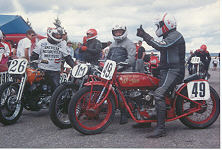
Here were the players in Pre-40 at that time. Butch Baer on his late 20’s Indian, Ozzie and the R51SS and Al Knapp on a 1937 Harley (I think it was a ’37).
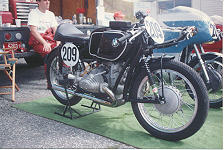
The famous RS54 Rennsport. While only a few riders (like Walter Zeller) were able to tame this bike for solo use, it dominated sidecar racing for many years.
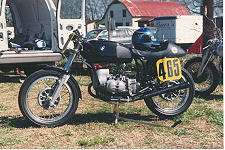
What an unbelievable power plant. Bevel gear valve actuation made this a very complex motor for the day, it produced incredible horsepower and more importantly torque. During a period from 1958 through 1968, eleven years, sidecars powered by this motor took 1st through 3rd 28 of the 33 possible slots at the Isle of Mann. I don’t think that any other statistic can say more.
One of the most successful bikes ever built in Ozzie’s shop. This little bike has been competing in the AHRMA 500 Sportsman Class since this first race in 1991. The last two years it has held the Number One plate. This bike combines the chassis stability of the BMW Slash 5 series with the horsepower and high revs of the Slash 2 series R50S. Much of the bike remains stock BMW including all of the internal drive train parts, all of the suspension parts and the brakes. With Ozzie’s son on board, this bike obliterates many bikes that cost twice as much new and many times more to develop.
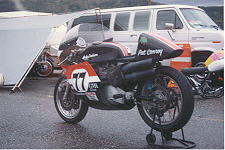
For all of you Harley fans, witness the KR750, the most race-able motor that Harley made until the current VR1000. Probably the only Harley made since WWII that isn’t better off as a boat anchor.
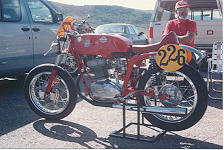
Always beautiful, this is one of the smaller Ducati’s.
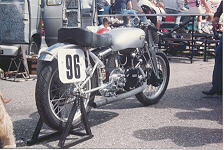
Seldom heard about in this country, Vincent made a 500cc bike that was essentially a one cylinder version of their bigger 1000cc bikes. Not many are converted to racing this bike. For good reason, it is just too heavy a bike to really do well, at least in this example. Still, it makes a wonderful piece of art at which we may marvel. I have heard them called either “Grey Flash” or the “Grey Comet”
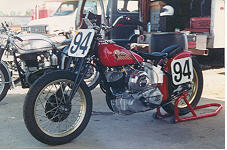
A perennial favorite, this Indian did well on smaller tracks – but had a hard time on big tracks like Daytona.
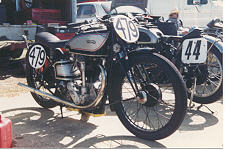
This exceptional machine, the Norton International was the predecessor to the fire breathing Norton Manx. This bike was very capable when introduced in the 1930’s – many street examples still provide excellent service today.
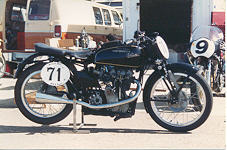
This bike created something of a controversy in the Pre-40 class for a while. This Velocette, much more indicative of Post-War Velo’s was seen in some Pre-40 photographs. Team Obsolete campaigned the bike for one year and then hung it up. Like all Velo’s it is beautiful
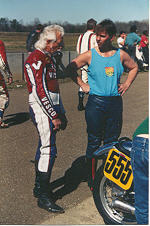
At one time, the Fastest Man on Two Wheels, Don Vesco has been one of those “Been There, Done that” kind of motorcycle racers. He has won Daytona and is known for being one of the first men to gain success on two strokes in the late sixties and early 70’s.
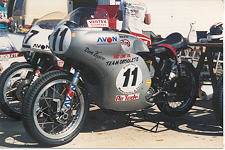
However, prior to switching to two-strokes, Don did very well on four-stroke machines. This is a Norton Manx that he rode in his career, owned by Team Obsolete, he rode the bike again at this race at Talladega in 1991.